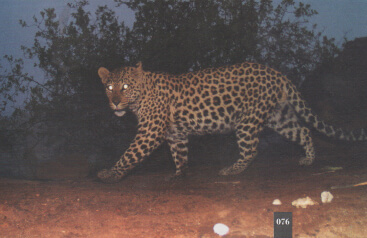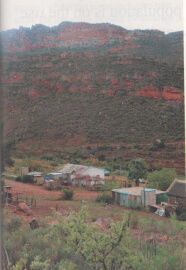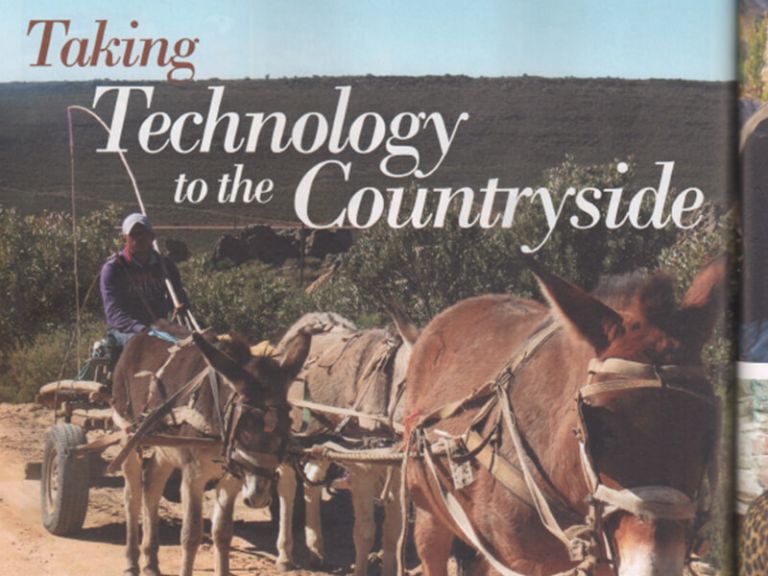Cuddeback cameras, smartphones and a UFO-lookalike called Skaapwagter have arrived in rural Cederberg, where trained locals have become data gatherers to help reduce livestock loss and to save the Cape leopard
There are times when Nature holds man's technological advances in her palm, and smiles. Such was the case deep in the Cederberg's mountainous terrain, where a team of researchers from the Cape Leopard Trust (CLT) was working into the night under head torches, on what is arguably one of South Africa's most robust leopard camera-trap surveys.
Unbeknown to the researchers, a leopard was languidly lying a few metres up on a rocky ledge, only a glance away from the team overseeing the installation of motion sensor cameras on either side of a track leading to a cave, to which the leopard returned from time to time.
Only later that night was the team made aware that their efforts to deploy cameras to capture the leopard's movements had been observed by the predator in question. In the Bushmans Kloof Wilderness Reserve, at the foot of the Cederberg mountains, staff and guests on a night drive had scanned the rock face with a spotlight and saw the leopard. But the researchers were focused on the camera-trap set-up and paid no attention to anything else.
It's a moot point as to who will have the last laugh. By examining the animal's unique pattern of rosette spots on its flanks, the team was later able to identify the leopard as a female already on file in the CLT database. The trust is looking to help safeguard the only free-roaming, terrestrial, apex predator still in existence in the Western Cape by obtaining detailed predator information from communities on the ground, through the use of sophisticated, high-technology equipment.
Residents of rural areas in the Cederberg have undergone on-site training in recording on camera what predator (if any) is responsible for a kill, as well as photographing livestock killed by a predator, identifying the predator through its spoor, killing method and teeth marks, and sending the information to the CLT by cellphone. All this will help to build a database on livestock predation and the Cape leopard population.
“We have extended the role played by communities in the conservation of the Cape leopard population,” says Cape Leopard Trust CEO Helen Turnbull. “Our efforts are now divided equally between people in communities around known leopard-roaming areas, as well as the species and the habitat that supports leopard territory.”
Helen says that the only way the trust can effectively protect leopards in the long term is to provide communities in rural areas such as the Cederberg with the skills and knowledge to help reduce livestock loss, and act as intelligence-gatherers on the ground.
“Our close involvement with these communities grew out of our recent camera trap survey undertaken in the Cederberg. We used 146 specialised, motion-sensor field cameras over an area of 1 700km?, to ascertain as far as possible the identities and population of leopards in the region [estimated between 500 and 1 000], as well as the size of their roaming areas, and their dietary habits. Running these types of surveys is time-intensive as the memory cards in the cameras have to be retrieved and camera batteries have to be changed relatively frequently.

Helen Turnbull, CEO of the Cape Leopard Trust

A carefully positioned camera captured this leopard as it headed down a trail.

Inspecting a Skaapwagter predator deterrent system in the field in Agterstevlei are (from the left) Chavoux Luyt, Ben Farmer, Frank Scheepers (partially hidden), Lana Müller, Esteano Oktober and Maggie Zimri.
CLT's Cederberg project manager Lana Müller adds, “The cameras capture high quality images night and day, provided they are positioned and set up correctly.
The images allow us to identify different leopards and establish population density, ascertain the relative abundance of prey species, and determine the time of day a species – leopard or prey – is active, by checking the date and time stamp on captured images.”
Communities bordering on leopard territory now have the use of the same camera equipment, and have undergone training as data gatherers to extend the reach of ongoing research into the habits of leopard in the Cederberg well into the future.
Residents of various hamlets in the Cederberg around the town of Wuppertal are using the specialised cameras, which come standard with motion-detection sensors, to record information about livestock kills. They have also been trained in the setting up of camera traps to help identify what predator is responsible for a specific kill. Smartphones are used, loaded with SMART (Spatial Monitoring and Reporting Tool), a sophisticated data collecting and reporting software, to feed information to CLT for inclusion in the organisation’s database on the Cape leopard.
The first two-day training workshop for verification officers nominated by community members in the Wuppertal area was held recently in the hamlet of Heuningvlei, led by Chavoux Luyt, the trust's community outreach officer, with input from Lana. The training included hands-on instruction in the use and set-up of the specialised Cuddeback cameras and the smartphones. The verification officers will act as CSI investigators in cases of predation, to provide an on-the-ground advisory service to community members about livestock kills.
“At community level, it's crucial that the verification officers have a good grasp of camera technology since they are in the forefront of gathering valuable data at incidents of livestock predation,” says Lana.
“By scrutinising the captured images, we are able to identify the predator feeding on the carcass, build a record of the ‘culprit and, if the predator is a leopard, discover which individual is involved. We've found that, often, the predator is not a leopard.”
Ben Farmer, Frank Scheepers and Rosco Ockhuis completed the intensive training programme and took delivery of cameras, smartphones, CLT clothing and donated bicycles. The fourth would-be verification officer Gerhard Swarts was guarding his potato crop against a troop of marauding baboons. He attended a separate training workshop later.
Only one of the three men, all long-time residents of the Cederberg region, has seen a Cape leopard, reputedly the most elusive of all wild animals in this rugged area. Rosco, whose father worked for CapeNature, as did he for two years, says, “I was lucky enough to see a leopard hunting a klipspringer.”

Wuppertal learners Johien Zass (12), Kyle Wynand (17), Waynie Zimri (6) and Keanu Rinkwest (16) are keenly aware of the mystique of leopard in the Cederberg. The two older boys are potential candidates for an educational programme launched by the trust to raise awareness in rural communities of job opportunities in the field of nature.

The Cape Leopard Trust sponsored some of the materials to reinforce Frank Scheepers' livestock kraal.

A night image of a leopard caught on a Cuddeback camera fitted with a motion-detector sensor.
Ben, when asked about leopard sightings, says, “I've been out in the field in the past with the Cape Leopard Trust and I was also present when a [radio-transmitter) collar was fitted to a leopard.”
Frank is enthusiastic about the enhanced ability of verification officers to assist Cederberg communities in improving their animal husbandry practices that ultimately will help to mitigate the incidence of human wildlife conflict.
The trust has also launched a new arm of its education programme focused on learners aged 13 to 16 in the buffer zones of CapeNature reserves around towns such as Wuppertal, Clanwilliam, Citrusdal, Elizabethfontein, Porterville and Piketberg. This will add capacity to the current programme that primarily serves the Boland.
In the past two years, more than 10 000 learners in rural and urban schools have attended annual workshops and overnight camps to learn about man's role in nurturing nature. “The Cape Leopard Trust believes that the education of people living side by side with leopards is the key to successful conservation, and this aligns with the trust's mantra of ensuring the long-term survival of leopards in the Cape for the benefit of nature and society,” says Helen.
An additional element of the CLT outreach programme is the loan of high-tech predator-deterrent devices called Skaapwagter (Shepherd) to rural communities and farmers, whose livestock is being killed by predators. It is common cause that leopards are frequently blamed for killing livestock, when other predators like foxes and wild cats or even packs of hunting dogs are responsible. Trained members of communities can now identify what predator was responsible, advise community members to move their livestock away from known predator trails, and help reinforce kraals to keep out predators.
To frighten off predators, the UFO lookalike Skaapwagter combines intermittent outbursts of recurring, flashing lights, as well as high-intensity sounds of varying frequency, and the irregular emission of a range of four odours that predators find offensive. The device is powered by solar energy and therefore requires minimal intervention while in the field.
Lana says that every few weeks the Skaapwagter units need to be moved to different locations around a hamlet or farm, and reinforced with changes in the sound and scent options available in the units, in order to introduce ‘difference' in the deterrent factor, and to reduce the risk of habituation by predators. “That's been our experience on commercial farms where we have installed the equipment.”
The CLT is also combining the use of the Skaapwagter device with the provision of sponsored reinforcement materials, to make community livestock kraals resistant to predators.
Agterstevlei hamlet's Maggie Zimri sums up the local communities' enthusiasm for about the efficacy of the Skaapwagter, “We've had no further animals taken since the Skaapwagter was set up in our community. I've been able to spend money on more animals because I feel they are safe from predators and I can now sleep well at night." It promises a win-win future all round.

Lana Müller, Cape Leopard Trust manager of the Cederberg Project, briefs new Cederberg community verification officers Frank Scheepers and Ben Farmer on the intricacies of a sophisticated Cuddeback camera.

Youngsters from rural and urban schools are introduced to leopard country by the Cape Leopard Trust to learn about nature on the ground.

The Agterstevlei hamlet is typical of the small communities that settled in the leopard country of the Cederberg generations ago.
















